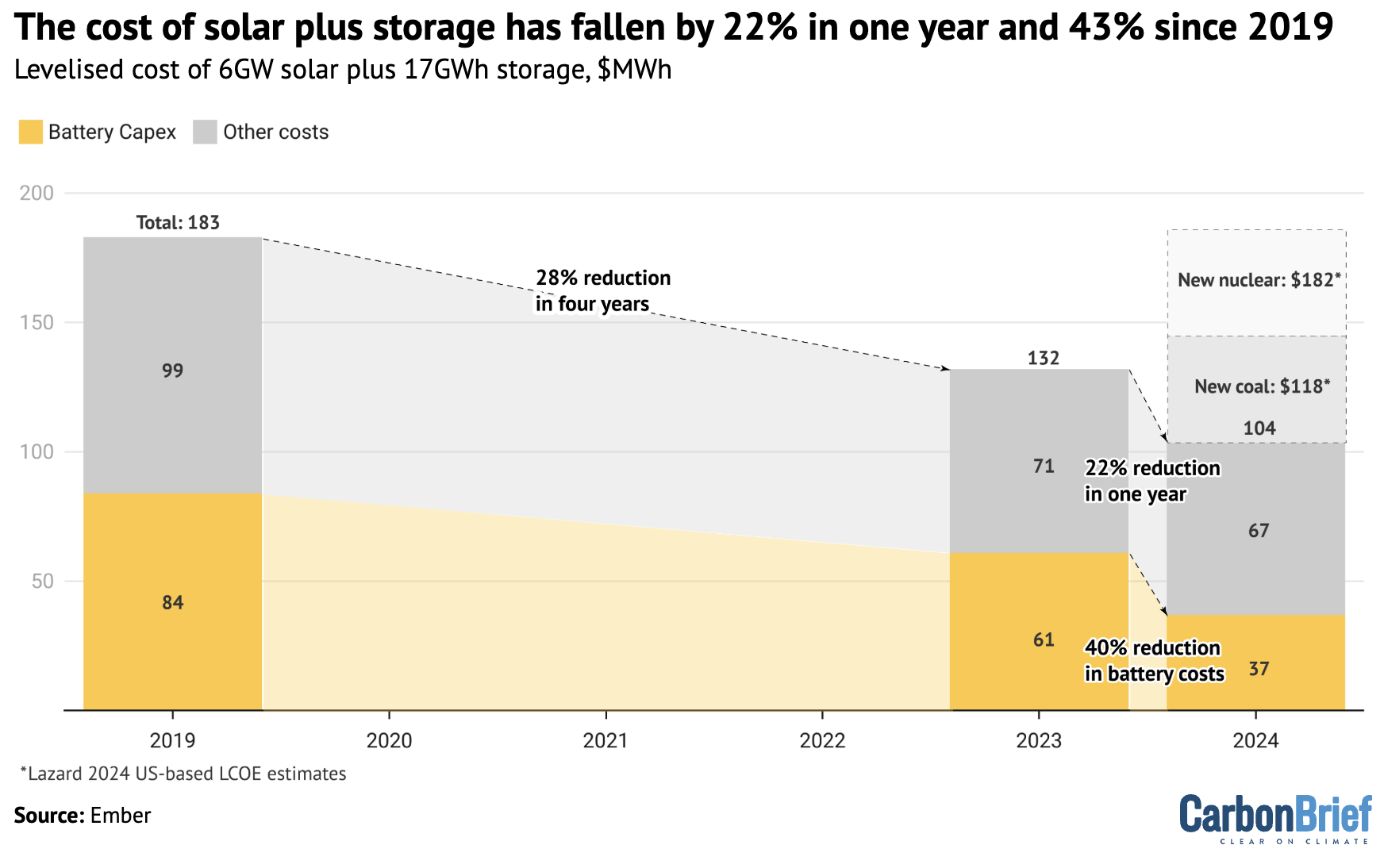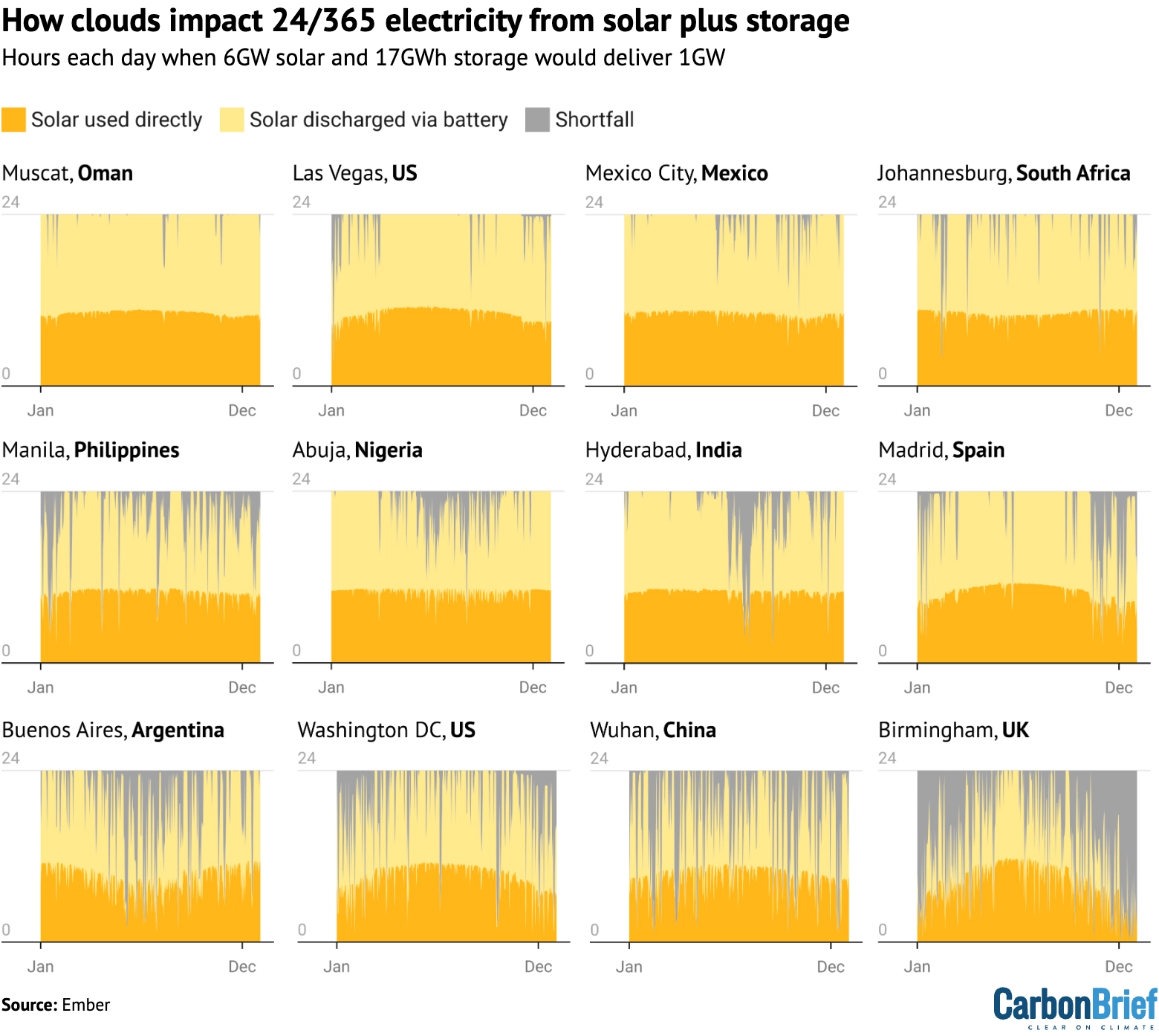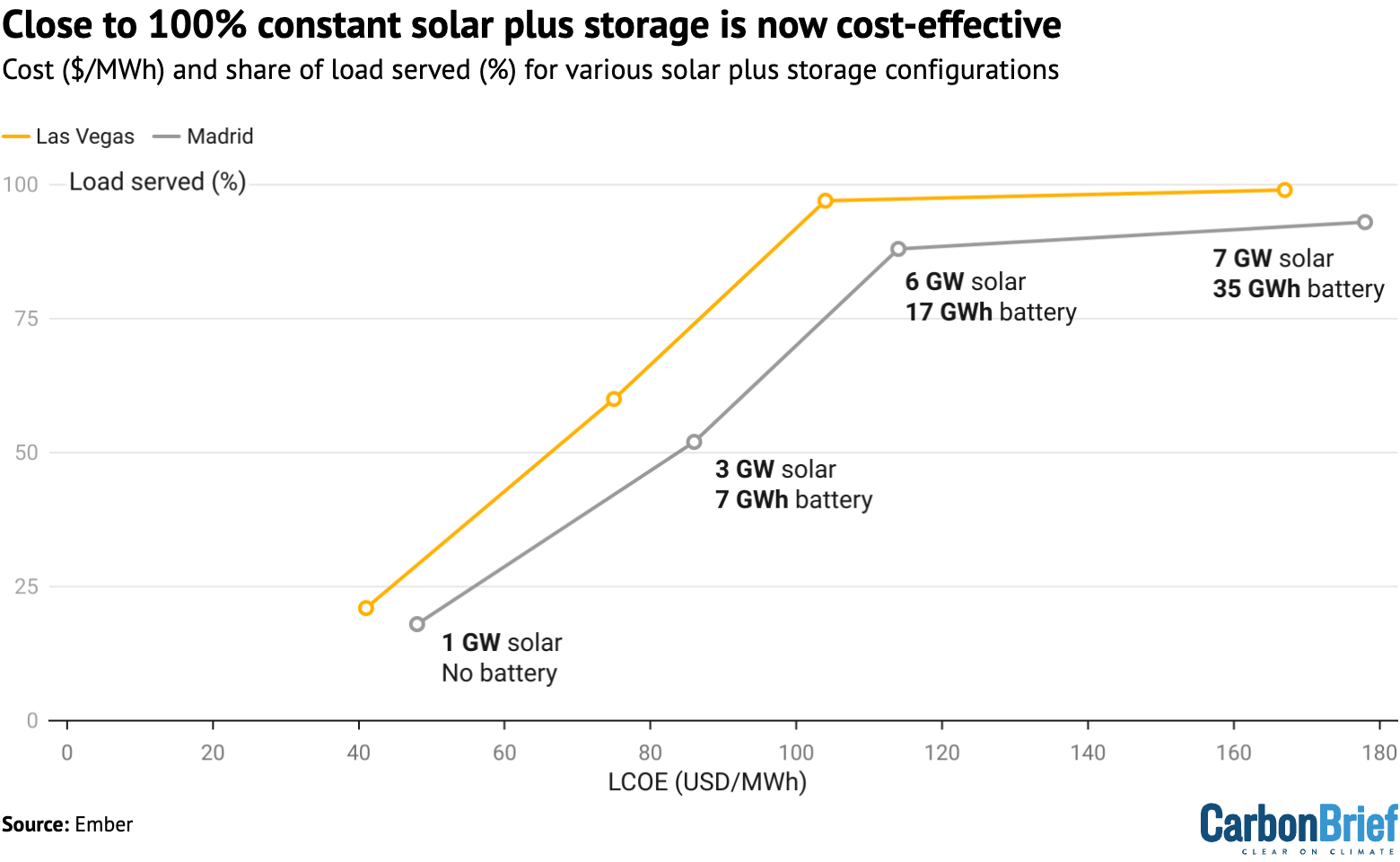A few years ago, solar power became the “cheapest electricity in history”, but it still lacked the ability to meet demand 24 hours a day and 365 days a year.
Since then, there have been significant improvements in the cost and performance of batteries, making it cheaper than ever to pair solar with energy storage using batteries.
In our new Ember “white paper”, we present modelling showing that solar with batteries in major sunny cities, such as Las Vegas or Mexico City, can now get more than 90% of the way to continuous generation, at costs below those of coal or nuclear power.
Even in cloudier cities away from the equator, such as Birmingham in the UK, it is possible to run on solar plus storage across the majority of hours in the year.
The white paper sets out how near-continuous “24/365” solar power has become an economic and technological reality in sunny regions.
Solar and storage ‘gamechangers’
A solar panel generates most electricity when the sun is shining, meaning it cannot provide constant power throughout the year. Put another way, 100 watts (W) of solar capacity only generates around 20W on average – and that output will be concentrated in daylight hours.
Our report shows that battery energy storage can unlock solar’s full potential, by turning daytime generation into around-the-clock electricity.
Indeed, when paired with sufficient battery storage, that same 100W of solar capacity can provide electricity around the clock – up to 100% of the time.
This also means up to five times as much solar generation can be delivered using the same connection to the electricity network, reducing the need for costly grid upgrades.
Battery energy storage is now cheaper than ever, with global average prices falling by 40% in 2024 alone. The cost of a full battery system fell to a record-low $165 per kilowatt hour (kWh), according to BloombergNEF.
Additionally, there have been a number of technological improvements boosting battery energy storage.
Recent innovations mean almost all grid batteries are now cobalt- and nickel-free, reducing the need for so-called “critical minerals”. They are longer-lasting than ever, with some batteries now having 20-year warranties. And they are safer than ever – with fire risk improving by a hundred-fold since 2019.
Improved container design has also cut maintenance and installation costs.
Our white paper shows that supply is ready to scale, with manufacturing capacity already exceeding demand. There is also significant new production capacity under construction outside of China.
The next frontier is sodium-ion “salt” batteries, which would eliminate the need for lithium and drive prices down even further. One large salt-battery plant has already been commissioned in China.
These technological advances and declining costs mean the world’s first “24/365” battery and solar plants are now coming online:
- In Hawaii, several solar-plus-battery projects are providing electricity through the night after the decommissioning of the last coal power plant in 2022.
- In the United Arab Emirates (UAE), at 100 megawatt (MW), Moro Hub is the world’s largest 100% solar-powered data centre, commissioned in 2022.
- In Saudi Arabia, a tourist mega project, including 16 hotel resorts that are all powered entirely by solar electricity, was completed in 2023.
- The first gigawatt-scale 24-hour solar project is already under development in the UAE. Emirati state-owned renewable energy company Masdar is leading the project, which was announced in January 2025 and will consist of a 5.2 gigawatt (GW) solar photovoltaic (PV) plant coupled with a 19 gigawatt hour (GWh) battery storage system to provide 1GW of uninterrupted solar electricity supply to the grid.
These examples show that 24/365 solar electricity has already been supplying customers and that it will increasingly start being used to power parts of the grid.
Cheaper in the sun
In order to investigate the potential for 24/365 solar, Ember’s white paper modelled a hypothetical system, using real weather data, for a series of cities around the world.
The modelling is based on a system with 6GW of solar capacity and 17GWh of battery storage, because there are roughly 15 hours of darkness in winter in the mid-latitudes.
The modelling shows that solar and battery in the sunniest cities could already get more than 90% of the way to 24/365 solar generation, covering almost every hour of every day in the year.
For example, Muscat in Oman could draw on 1GW of continuous solar electricity for 99% of hours in the year, if it paired 6GW of solar panels with 17GWh of battery capacity.
Las Vegas in the US, Mexico City in Mexico and Johannesburg in South Africa could all rely on such solar-plus-storage systems for at least 95% of hours in the year.
Even Birmingham in the UK could achieve 1GW of solar output for 62% of hours annually. (This is lower than for sunnier cities due to a stronger seasonal cycle and cloudier weather.)
In the sunniest places, solar and storage could generate reliable output, close to 24/365, for around $100 per megawatt hour (MWh), based on average global costs for solar and batteries in 2024.
For each city, the yellow shading in the figure below shows the share of hours each year that it could rely on 1GW of solar output if it installed a 6GW solar plus 17GWh battery system, given historical weather conditions.

Over the past year alone, the levelised cost of electricity (LCOE) for solar-plus-storage systems fell by 22%, driven by a 40% fall in battery prices. This is based on $165/kWh, which was BloombergNEF’s assessment of the global battery pack price at the end of 2024. The LCOE of solar and battery had fallen by 28% over the previous four years.
This makes solar with battery storage cheaper than both coal and nuclear when compared with US-based LCOE, as shown in the chart below.

There is evidence that 2025 solar and battery prices will continue to fall again. Already in early 2025, tenders for large-scale battery storage projects in Tabuk and Hail, Saudi Arabia, reported battery prices as low as $72/kWh.
Cloudy day challenges
Our modelling shows that the greatest challenge to generating constant, year-round electricity from solar plus storage is not nighttime, but clouds.
In the mid-latitudes, with around 15 hours of darkness in winter, around 17 hours of battery capacity is sufficient to bridge the period from sunset to sunrise.
This is because batteries typically do not fully charge and discharge to maintain high performance over time.
However, getting to 24/365 solar is harder, as while every day has daylight, not every day has full sunlight. Even though clouds do not reduce solar generation to zero – and despite batteries being cheaper than ever – extra battery storage is still not an economical option for bridging cloudy periods across multiple days.
The graphic below illustrates this, based on the same 6GW solar plus 17GWh storage system as described before, generating electricity under the weather conditions and seasonal cycles of the same 12 cities around the world.
The chart for each city runs from January to December on the horizontal axis and across 24 hours of each day on the vertical axis. Direct use of solar power is shown in orange, with stored solar from the battery shown in yellow and periods with a shortfall in dark blue.
The figure shows that, even on the cloudiest day of the year in Muscat, this solar-plus-storage system would generate constant electricity for 18 hours. Madrid in Spain would see lower output on some shorter and cloudier days in November, December and January. In contrast, Hyderabad in India would be impacted in the summer by cloudy monsoon days.
Overall, the figure shows that the sunniest cities would only fall slightly short of 24/365 solar electricity, but clouds would have a larger impact elsewhere.

The trade-off
The International Energy Agency (IEA) has described solar power as offering the “cheapest electricity in history”.
For example, solar power costs just $41/MWh in Las Vegas, according to Ember’s calculations using average global equipment and borrowing costs. However, this is only delivering electricity through daytime hours. As a result, on average around the world, solar has a “capacity factor” of 21% – meaning each unit of solar capacity generates 21% of its maximum theoretical output.
Raising this all the way to 97% raises the price to $104/MWh. However, this also substantially improves the value of solar, now that it is delivering close to 24/365. However, as the chart below shows, meeting the last few percent of demand from solar and storage alone significantly increases the price.
The best value between solar alone or solar with plentiful storage depends on the use case.
It may be optimal to build solar without a battery, so long as a factory can access cheap grid electricity when the solar panels are not generating, for example.
On the other hand, it may be optimal to build solar and batteries to get to 99.7% for an off-grid data centre that values reliability over price. Even in the most sunny places, exactly 100% supply will generally be uneconomic – but it is possible to get very close.

For many cases and based on current prices, the sweet spot may be to size the system for a constant supply of solar electricity for 60-90% of the time, our modelling suggests.
This provides cheap, low-carbon solar power most of the time. It would enable electricity to be used flexibly through the night or during high-price hours.
If widely deployed, such systems would allow for a significantly downscaled need for grid investment, whether they are large-scale solar farms exporting more electricity to the grid or industrial sites drawing from public supplies less often.
The post Guest post: How solar panels and batteries can now run ‘close to 24/365’ in some cities appeared first on Carbon Brief.





